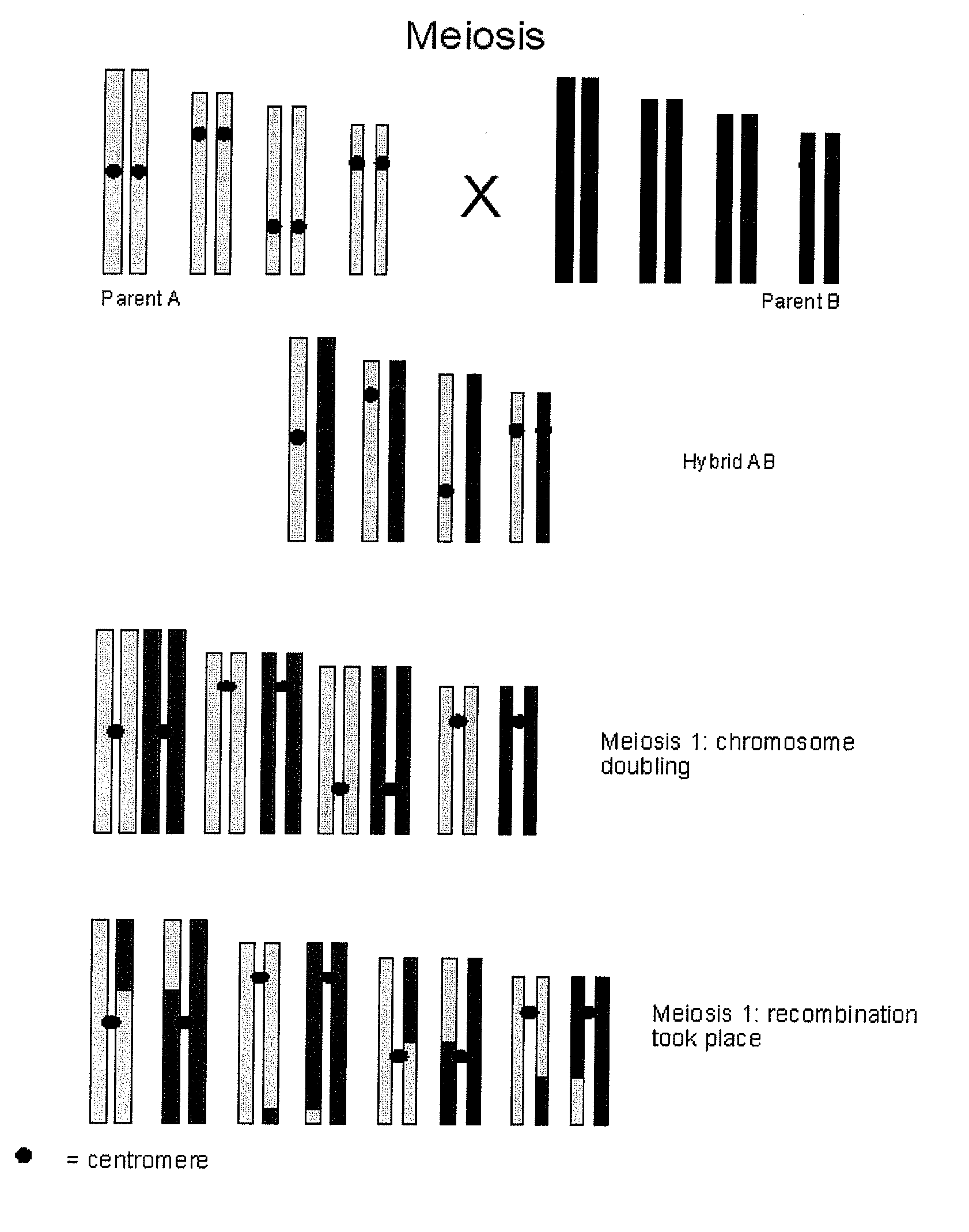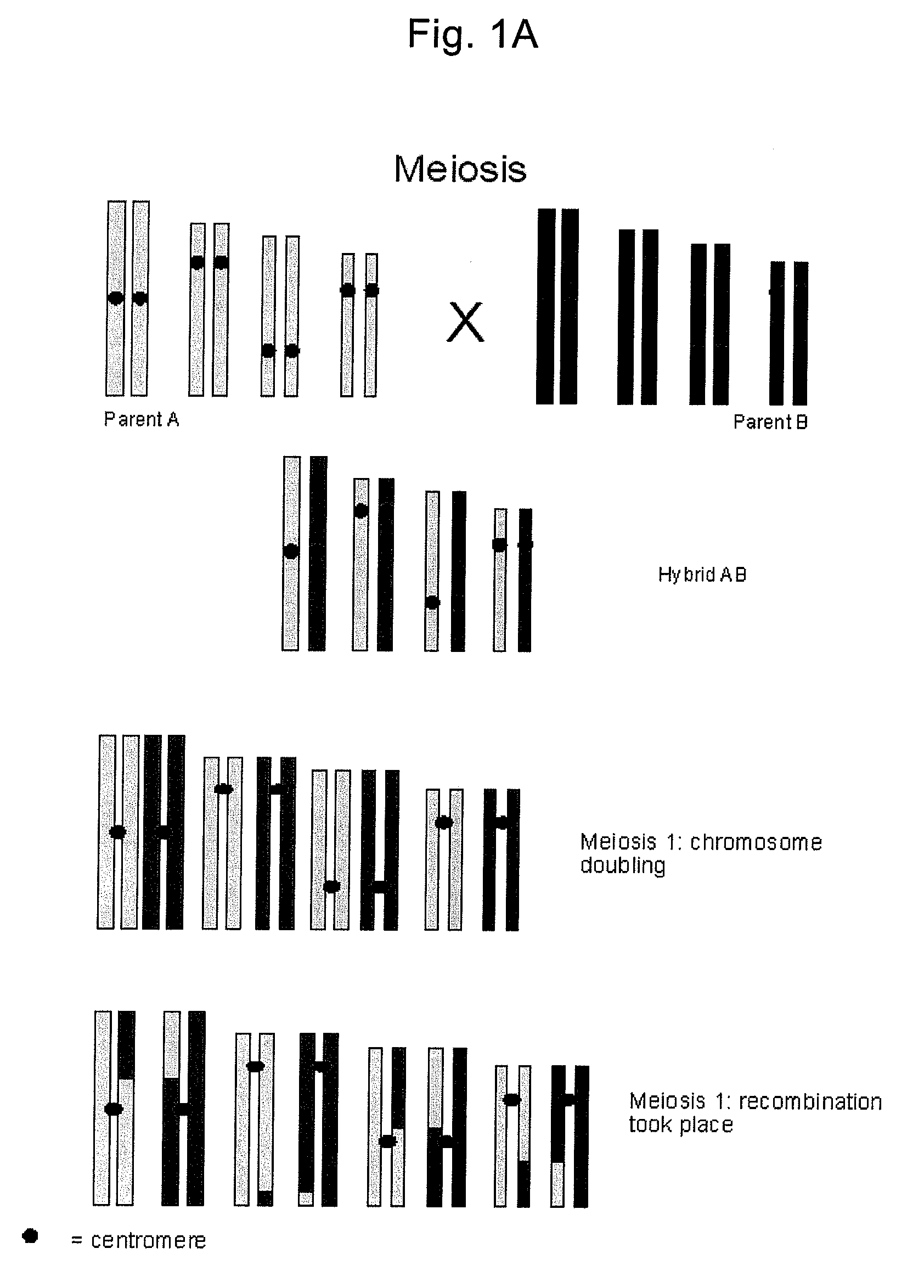Near Reverse Breeding
a technology of reverse breeding and plant, applied in the field of plants, can solve the problems of loss of commercially desirable traits, affecting the quality of plants, and generating genetically dissimilar and therefore heterogeneous plants, so as to reduce complexity and increase the chances
- Summary
- Abstract
- Description
- Claims
- Application Information
AI Technical Summary
Benefits of technology
Problems solved by technology
Method used
Image
Examples
example 1
Demonstration of the Occurrence of a Relatively Low Level of Heterozygocity in Cucumber (Cucumis Sativus L.) Plants Obtained Through Gynogenesis
[0096] By making haploids and doubled haploids in cucumber according to EP-374755 it was found by using AFLP analysis (carried out according to EP-534858) that among the expected doubled haploids, a certain percentage proved to be not originated from haploid megaspores but rather to be derived from an unreduced megaspore (2 n). This is well demonstrated in FIGS. 5, 6 and 7 which shown that the originally presumed doubled haploids (FIG. 6) still contain heterozygous sectors, which by definition is not possible in true doubled haploids.
[0097] This example shows that through gynogenesis in cucumber DHs can be obtained but that in addition plants are obtained which show some regions which are heterozygous. This level of heterozygocity is strongly reduced as compared to the F2 generation and is therefore most likely caused by an SDR-like mechan...
example 2
Enhancement of the Formation of Unreduced Spores / Gametes in Sweet Pepper (Capsicum Annuum L.)
[0098] In order to increase the frequency of unreduced spore / gamete formation, cold stress was applied as an inducer. For this purpose, flowering plants of sweet pepper containing pre-meiotic floral buds and growing at 23° C. were exposed for 5 days to 11° C. according to Zhang et al. (2002) Journal of Horticultural Science &Biotechnology 78, 84-88. After this cold shock, the buds were harvested and pollen was extracted by opening the anthers using dissecting forceps and scalpel. The pollen were subsequently transferred on a microscopic glass slide and stained for viability using a drop of aceto-carmine. Cover slides were put on top of the suspension which was investigated using light-microscopy. As a control, pollen was collected form sweet pepper plants which were grown at 23° C.
[0099]FIG. 8 shows representative examples of the morphologies of the pollen collected from the cold-treated p...
example 3
Enrichment of Naturally Occurring Diploid Spores in Broccoli (Brassica Oleracea L.) Through Flow Cytometry
[0100] For broccoli (and other plant species) it is known that diploid spores are larger than haploid spores. In order to determine whether it is feasible to enrich for diploid spores using flow cytometry different mixtures were made of spores obtained from diploid and tetraploid plants. Spores were isolated by grinding floral buds (3-4 mm in size) in a buffer solution (8.2 g / L NaCl, 1.9 g / L Na2HPO4.2H2O, 0.3 g / L NaH2PO4.2H2O, pH=7.4) and subsequent filtering through a 110 μM filter. The cells were washed twice with the extraction buffer and counted.
[0101] The following mixtures were made of haploid versus diploid cells: 1:1, 10:1 and 100:1. Sorting was carried out on the basis of the parameters granularity, vitality and size. Enrichment of diploid cells was obtained for all ratios and based on each of the three parameters. In a next experiment a natural population of haploid ...
PUM
| Property | Measurement | Unit |
|---|---|---|
| Fraction | aaaaa | aaaaa |
| Fraction | aaaaa | aaaaa |
| Temperature | aaaaa | aaaaa |
Abstract
Description
Claims
Application Information
 Login to View More
Login to View More - R&D
- Intellectual Property
- Life Sciences
- Materials
- Tech Scout
- Unparalleled Data Quality
- Higher Quality Content
- 60% Fewer Hallucinations
Browse by: Latest US Patents, China's latest patents, Technical Efficacy Thesaurus, Application Domain, Technology Topic, Popular Technical Reports.
© 2025 PatSnap. All rights reserved.Legal|Privacy policy|Modern Slavery Act Transparency Statement|Sitemap|About US| Contact US: help@patsnap.com



